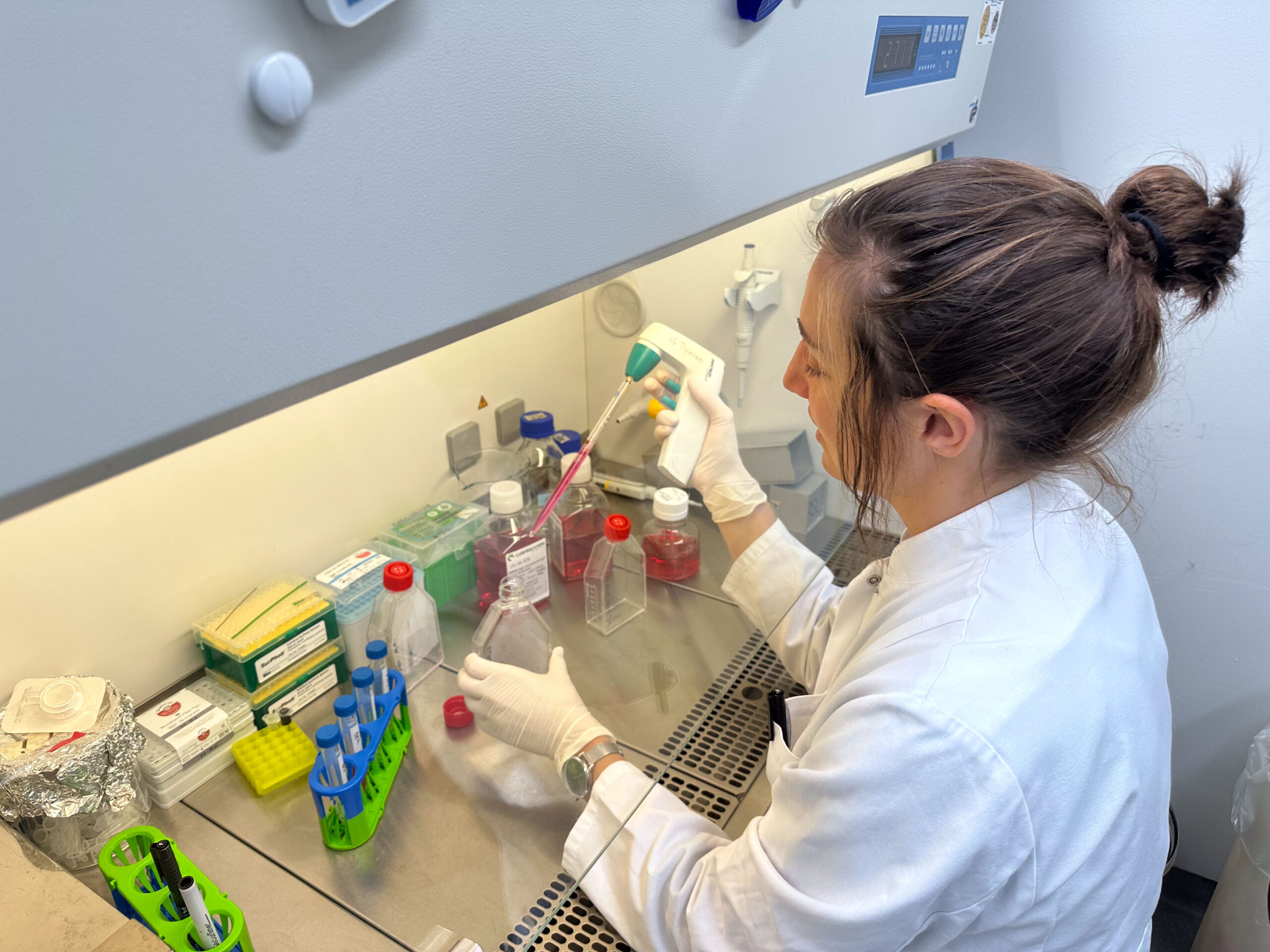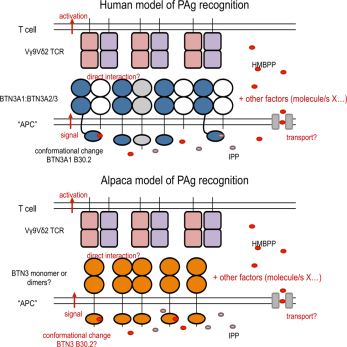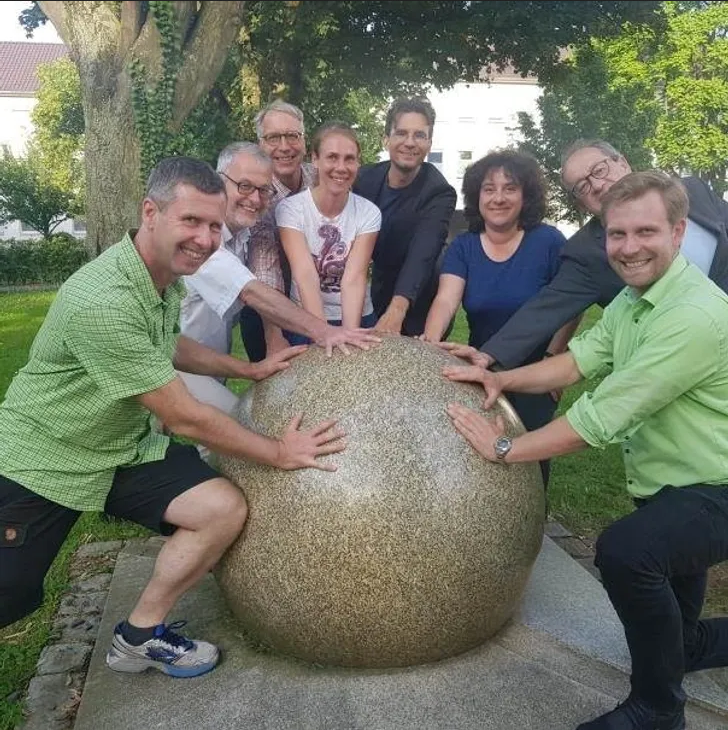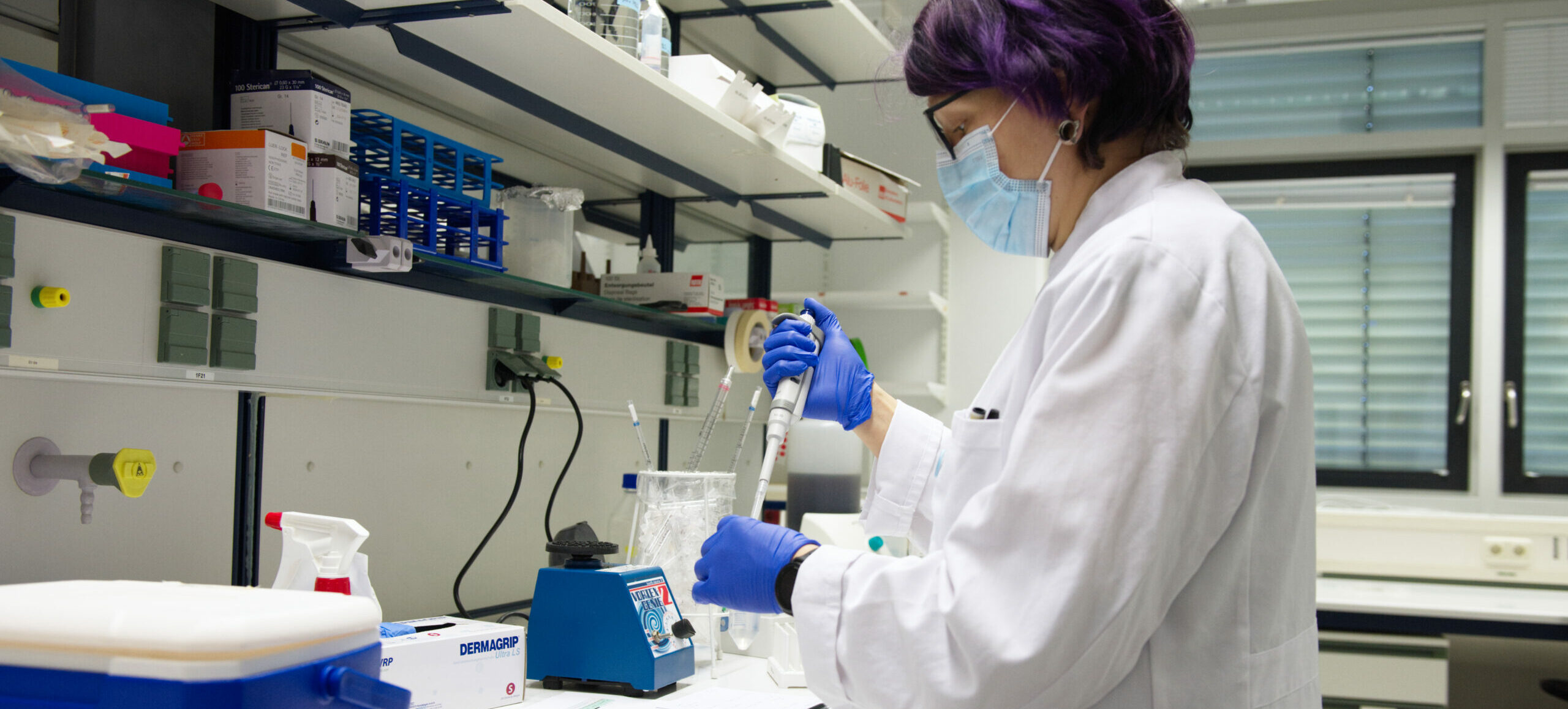Publications
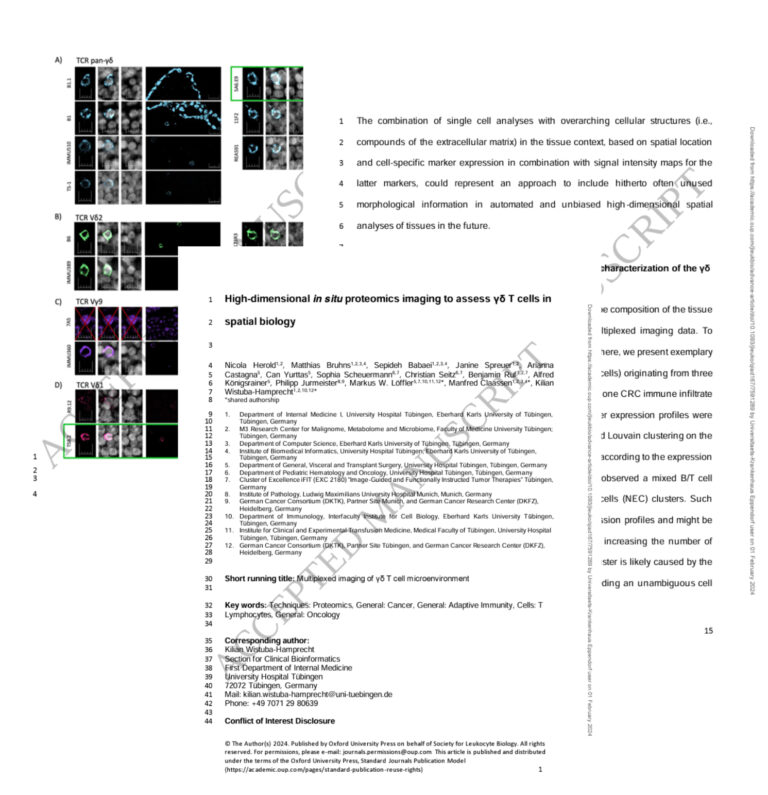
High-dimensional in situ proteomics imaging to assess γδ T cells in spatial biology
This study presents a high-dimensional immunohistochemistry approach to assess human γδ T cell subsets in their native tissue microenvironments at spatial resolution, a hitherto unmet scientific goal due to the lack of established antibodies and required technology. We report an integrated approach based on multiplexed imaging and bioinformatic analysis to identify γδ T cells, characterize their phenotypes, and analyze the composition of their microenvironment. Twenty-eight γδ T cell microenvironments were identified in tissue samples from fresh frozen human colon and colorectal cancer where interaction partners of the immune system but also cancer cells were discovered in close proximity to γδ T cells, visualizing their potential contributions to cancer immunosurveillance. While this proof-of-principle study demonstrates the potential of this cutting-edge technology to assess γδ T cell heterogeneity and to investigate their microenvironment, future comprehensive studies are warranted to associate phenotypes and microenvironment profiles with features such as relevant clinical characteristics.
J Leukoc Biol. 2024 Jan 29
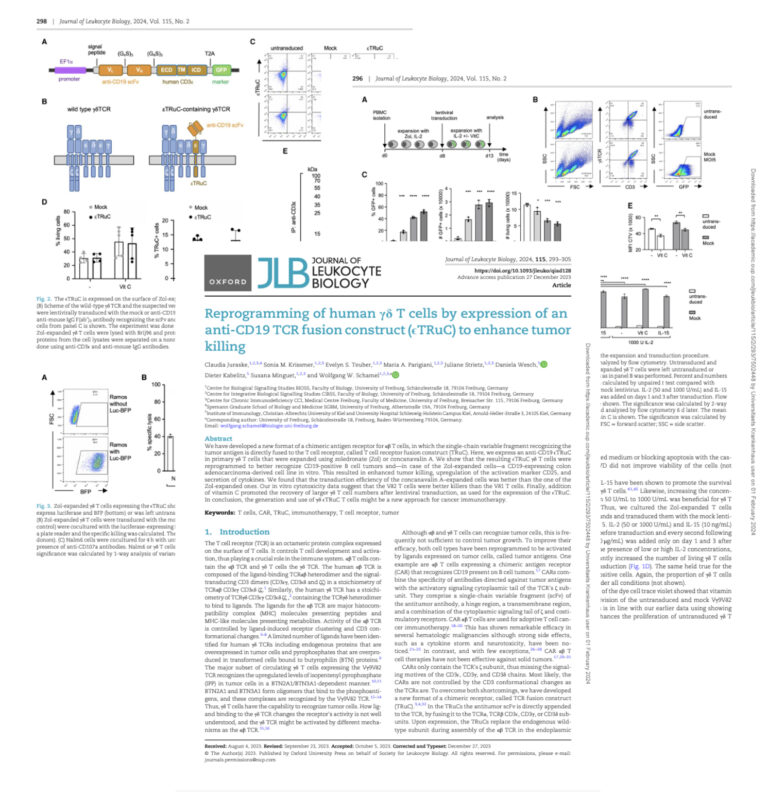
Reprogramming of human γδ T cells by expression of an anti-CD19 TCR fusion construct (εTRuC) to enhance tumor killing
We have developed a new format of a chimeric antigen receptor for αβ T cells, in which the single-chain variable fragment recognizing the tumor antigen is directly fused to the T cell receptor, called T cell receptor fusion construct (TRuC). Here, we express an anti-CD19 εTRuC in primary γδ T cells that were expanded using zoledronate (Zol) or concanavalin A. We show that the resulting εTRuC γδ T cells were reprogrammed to better recognize CD19-positive B cell tumors and-in case of the Zol-expanded cells-a CD19-expressing colon adenocarcinoma-derived cell line in vitro. This resulted in enhanced tumor killing, upregulation of the activation marker CD25, and secretion of cytokines. We found that the transduction efficiency of the concanavalin A-expanded cells was better than the one of the Zol-expanded ones. Our in vitro cytotoxicity data suggest that the Vδ2 T cells were better killers than the Vδ1 T cells. Finally, addition of vitamin C promoted the recovery of larger γδ T cell numbers after lentiviral transduction, as used for the expression of the εTRuC. In conclusion, the generation and use of γδ εTRuC T cells might be a new approach for cancer immunotherapy.
J Leukoc Biol. 2024 Jan 19;115(2):293-305
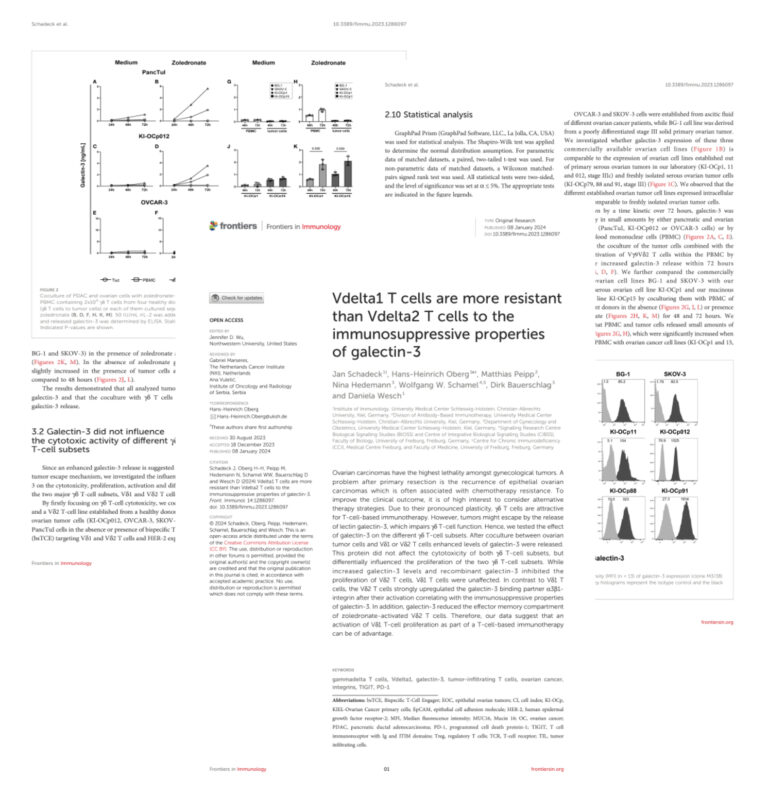
Vdelta1 T cells are more resistant than Vdelta2 T cells to the immunosuppressive properties of galectin-3
Ovarian carcinomas have the highest lethality amongst gynecological tumors. A problem after primary resection is the recurrence of epithelial ovarian carcinomas which is often associated with chemotherapy resistance. To improve the clinical outcome, it is of high interest to consider alternative therapy strategies. Due to their pronounced plasticity, γδ T cells are attractive for T-cell-based immunotherapy. However, tumors might escape by the release of lectin galectin-3, which impairs γδ T-cell function. Hence, we tested the effect of galectin-3 on the different γδ T-cell subsets. After coculture between ovarian tumor cells and Vδ1 or Vδ2 T cells enhanced levels of galectin-3 were released. This protein did not affect the cytotoxicity of both γδ T-cell subsets, but differentially influenced the proliferation of the two γδ T-cell subsets. While increased galectin-3 levels and recombinant galectin-3 inhibited the proliferation of Vδ2 T cells, Vδ1 T cells were unaffected. In contrast to Vδ1 T cells, the Vδ2 T cells strongly upregulated the galectin-3 binding partner α3β1-integrin after their activation correlating with the immunosuppressive properties of galectin-3. In addition, galectin-3 reduced the effector memory compartment of zoledronate-activated Vδ2 T cells. Therefore, our data suggest that an activation of Vδ1 T-cell proliferation as part of a T-cell-based immunotherapy can be of advantage.
Front Immunol. 2024 Jan 8:14:1286097
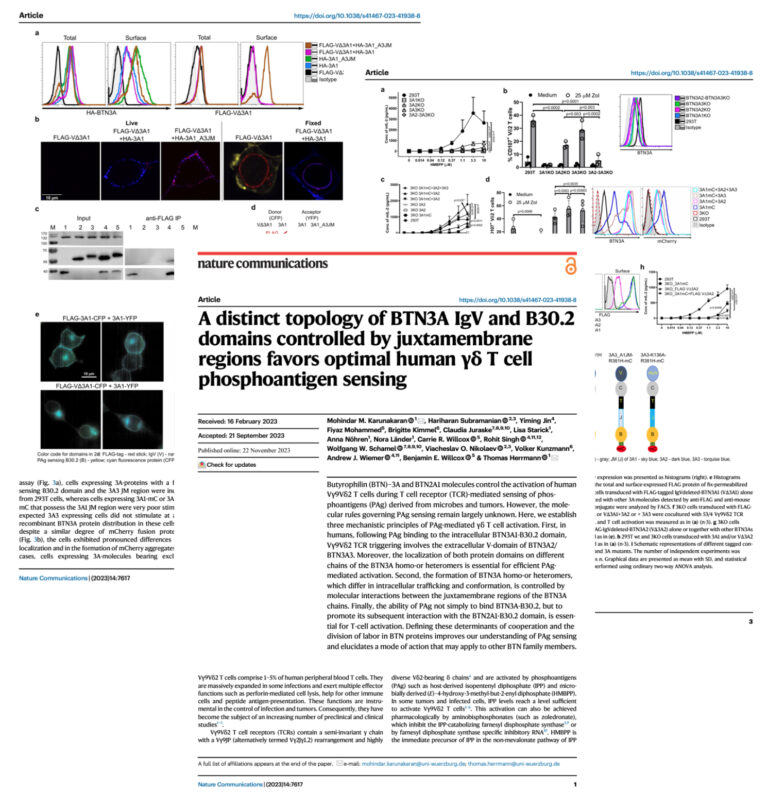
A distinct topology of BTN3A IgV and B30.2 domains controlled by juxtamembrane regions favors optimal human γδ T cell phosphoantigen sensing
Butyrophilin (BTN)-3A and BTN2A1 molecules control the activation of human Vγ9Vδ2 T cells during T cell receptor (TCR)-mediated sensing of phosphoantigens (PAg) derived from microbes and tumors. However, the molecular rules governing PAg sensing remain largely unknown. Here, we establish three mechanistic principles of PAg-mediated γδ T cell activation. First, in humans, following PAg binding to the intracellular BTN3A1-B30.2 domain, Vγ9Vδ2 TCR triggering involves the extracellular V-domain of BTN3A2/BTN3A3. Moreover, the localization of both protein domains on different chains of the BTN3A homo-or heteromers is essential for efficient PAg-mediated activation. Second, the formation of BTN3A homo-or heteromers, which differ in intracellular trafficking and conformation, is controlled by molecular interactions between the juxtamembrane regions of the BTN3A chains. Finally, the ability of PAg not simply to bind BTN3A-B30.2, but to promote its subsequent interaction with the BTN2A1-B30.2 domain, is essential for T-cell activation. Defining these determinants of cooperation and the division of labor in BTN proteins improves our understanding of PAg sensing and elucidates a mode of action that may apply to other BTN family members.
Nat Commun. 2023 Nov 22;14(1):7617
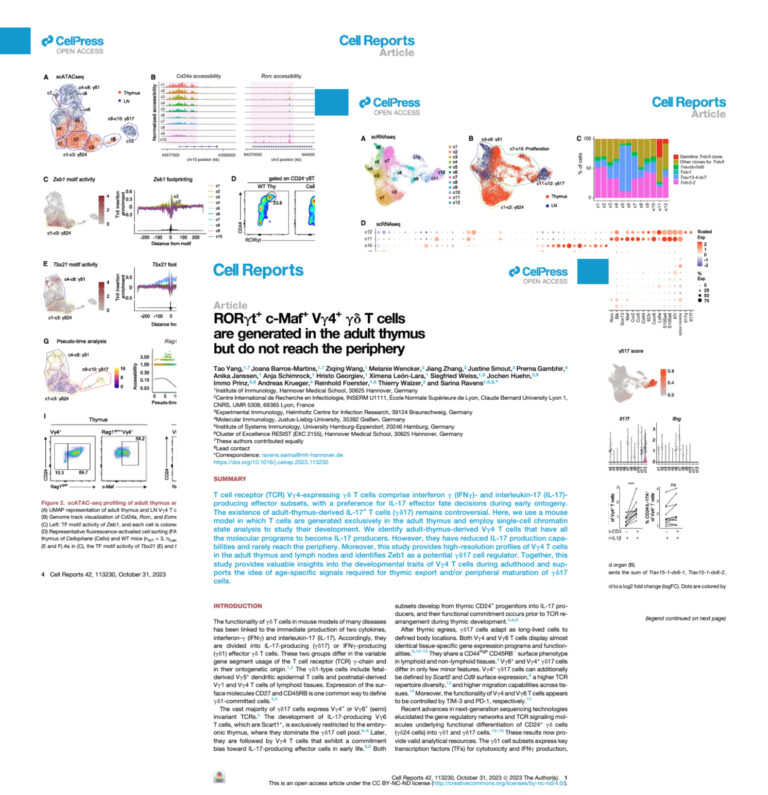
RORγt+ c-Maf+ Vγ4+ γδ T cells are generated in the adult thymus but do not reach the periphery
T cell receptor (TCR) Vγ4-expressing γδ T cells comprise interferon γ (IFNγ)- and interleukin-17 (IL-17)-producing effector subsets, with a preference for IL-17 effector fate decisions during early ontogeny. The existence of adult-thymus-derived IL-17+ T cells (γδ17) remains controversial. Here, we use a mouse model in which T cells are generated exclusively in the adult thymus and employ single-cell chromatin state analysis to study their development. We identify adult-thymus-derived Vγ4 T cells that have all the molecular programs to become IL-17 producers. However, they have reduced IL-17 production capabilities and rarely reach the periphery. Moreover, this study provides high-resolution profiles of Vγ4 T cells in the adult thymus and lymph nodes and identifies Zeb1 as a potential γδ17 cell regulator. Together, this study provides valuable insights into the developmental traits of Vγ4 T cells during adulthood and supports the idea of age-specific signals required for thymic export and/or peripheral maturation of γδ17 cells.
Cell Rep. 2023 Oct 9;42(10):113230
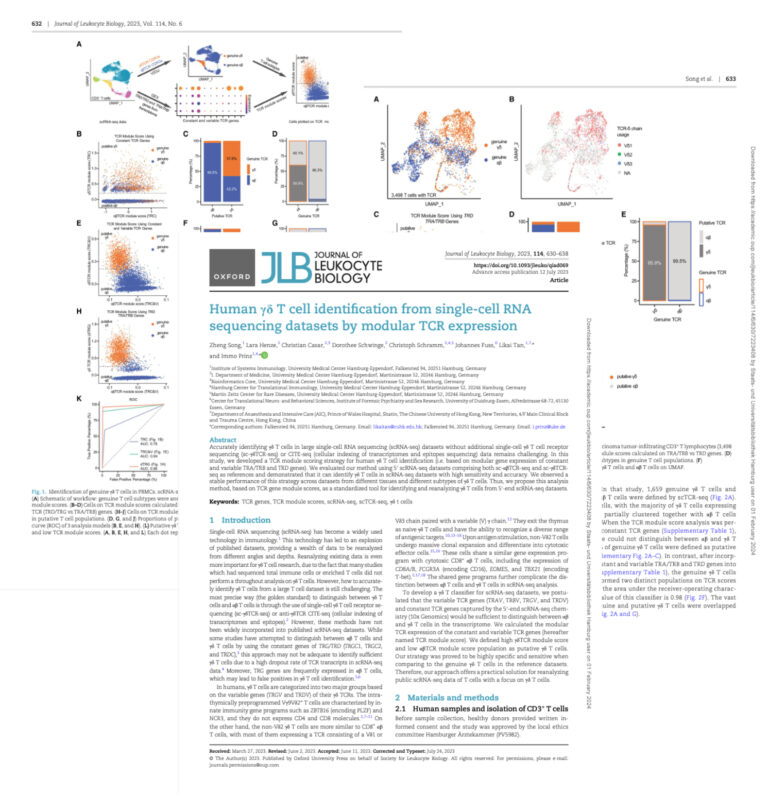
Human γδ T cell Identification from Single-cell RNA Sequencing Datasets by Modular TCR Expression
Accurately identifying γδ T cells in large single-cell RNA sequencing (scRNA-seq) datasets without additional sc-γδTCR-seq or CITE-seq data remains challenging. In this study, we developed a TCR module scoring strategy for human γδ T cell identification, that is based on modular gene expression of constant and variable TRA/TRB and TRD genes. We evaluated our method using 5' scRNA-seq datasets comprising both sc-αβTCR-seq and sc-γδTCR-seq as references and demonstrated that it can identify γδ T cells in scRNA-seq datasets with high sensitivity and accuracy. We observed a stable performance of this strategy across datasets from different tissues and different subtypes of γδ T cells. Thus, we propose this analysis method, based on TCR gene module scores, as a standardized tool for identifying and reanalyzing γδ T cells from 5'-end scRNA-seq datasets.
J Leukoc Biol. 2023 Jul 12:qiad069
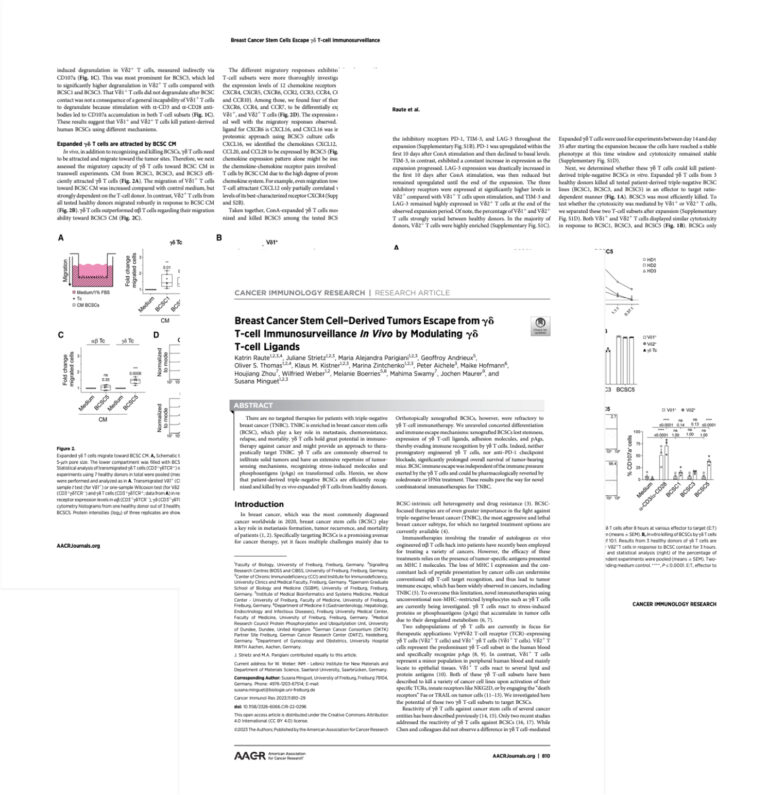
Breast Cancer Stem Cell-Derived Tumors Escape from γδ T-cell Immunosurveillance In Vivo by Modulating γδ T-cell Ligands
There are no targeted therapies for patients with triple-negative breast cancer (TNBC). TNBC is enriched in breast cancer stem cells (BCSC), which play a key role in metastasis, chemoresistance, relapse, and mortality. γδ T cells hold great potential in immunotherapy against cancer and might provide an approach to therapeutically target TNBC. γδ T cells are commonly observed to infiltrate solid tumors and have an extensive repertoire of tumor-sensing mechanisms, recognizing stress-induced molecules and phosphoantigens (pAgs) on transformed cells. Herein, we show that patient-derived triple-negative BCSCs are efficiently recognized and killed by ex vivo expanded γδ T cells from healthy donors. Orthotopically xenografted BCSCs, however, were refractory to γδ T-cell immunotherapy. We unraveled concerted differentiation and immune escape mechanisms: xenografted BCSCs lost stemness, expression of γδ T-cell ligands, adhesion molecules, and pAgs, thereby evading immune recognition by γδ T cells. Indeed, neither promigratory engineered γδ T cells, nor anti-PD-1 checkpoint blockade, significantly prolonged overall survival of tumor-bearing mice. BCSC immune escape was independent of the immune pressure exerted by the γδ T cells and could be pharmacologically reverted by zoledronate or IFNα treatment. These results pave the way for novel combinatorial immunotherapies for TNBC.
Cancer Immunol Res. 2023 Jun 2;11(6):810-829
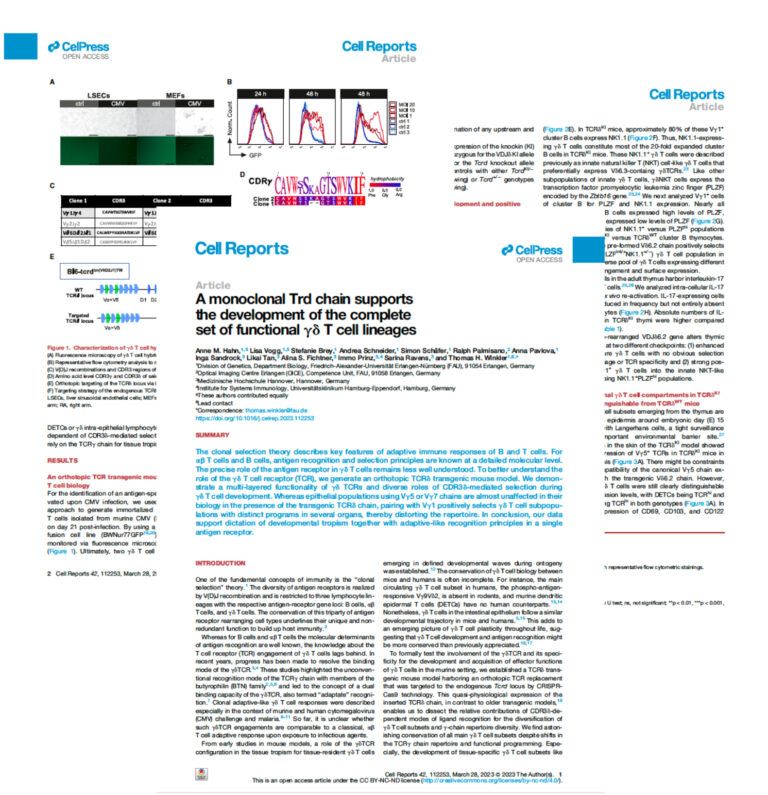
A monoclonal Trd chain supports the development of the complete set of functional γδ T cell lineages
The clonal selection theory describes key features of adaptive immune responses of B and T cells. For αβ T cells and B cells, antigen recognition and selection principles are known at a detailed molecular level. The precise role of the antigen receptor in γδ T cells remains less well understood. To better understand the role of the γδ T cell receptor (TCR), we generate an orthotopic TCRδ transgenic mouse model. We demonstrate a multi-layered functionality of γδ TCRs and diverse roles of CDR3δ-mediated selection during γδ T cell development. Whereas epithelial populations using Vγ5 or Vγ7 chains are almost unaffected in their biology in the presence of the transgenic TCRδ chain, pairing with Vγ1 positively selects γδ T cell subpopulations with distinct programs in several organs, thereby distorting the repertoire. In conclusion, our data support dictation of developmental tropism together with adaptive-like recognition principles in a single antigen receptor.
Cell Rep. 2023 Mar 14;42(3):112253
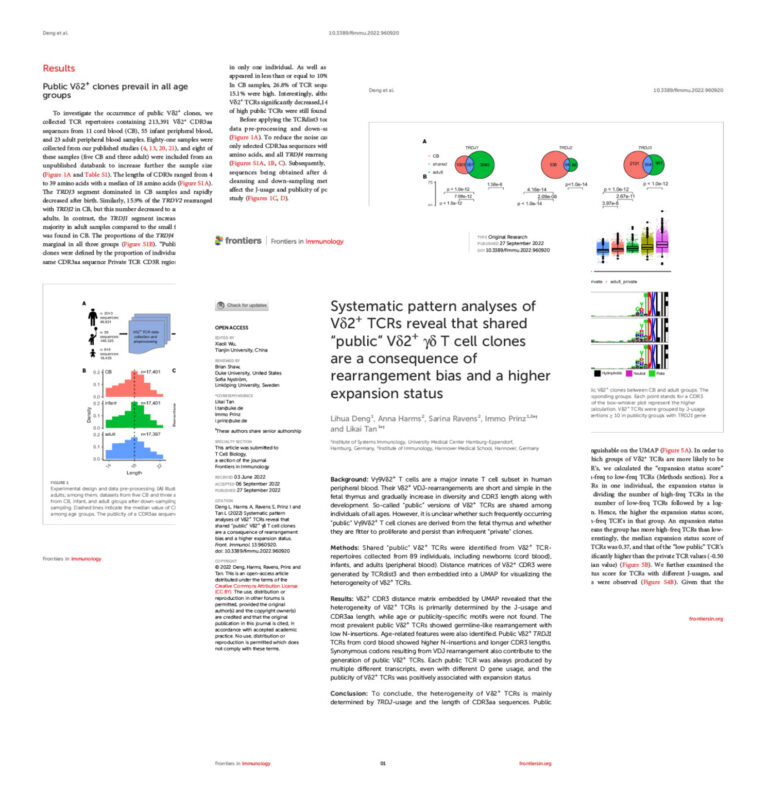
Systematic pattern analyses of Vδ2+ TCRs reveal that shared "public" Vδ2+ γδ T cell clones are a consequence of rearrangement bias and a higher expansion status
δ2+ CDR3 distance matrix embedded by UMAP revealed that the heterogeneity of Vδ2+ TCRs is primarily determined by the J-usage and CDR3aa length, while age or publicity-specific motifs were not found. The most prevalent public Vδ2+ TCRs showed germline-like rearrangement with low N-insertions. Age-related features were also identified. Public Vδ2+ TRDJ1 TCRs from cord blood showed higher N-insertions and longer CDR3 lengths. Synonymous codons resulting from VDJ rearrangement also contribute to the generation of public Vδ2+ TCRs. Each public TCR was always produced by multiple different transcripts, even with different D gene usage, and the publicity of Vδ2+ TCRs was positively associated with expansion status.
Front Immunol. 2022 Sep 27:13:960920
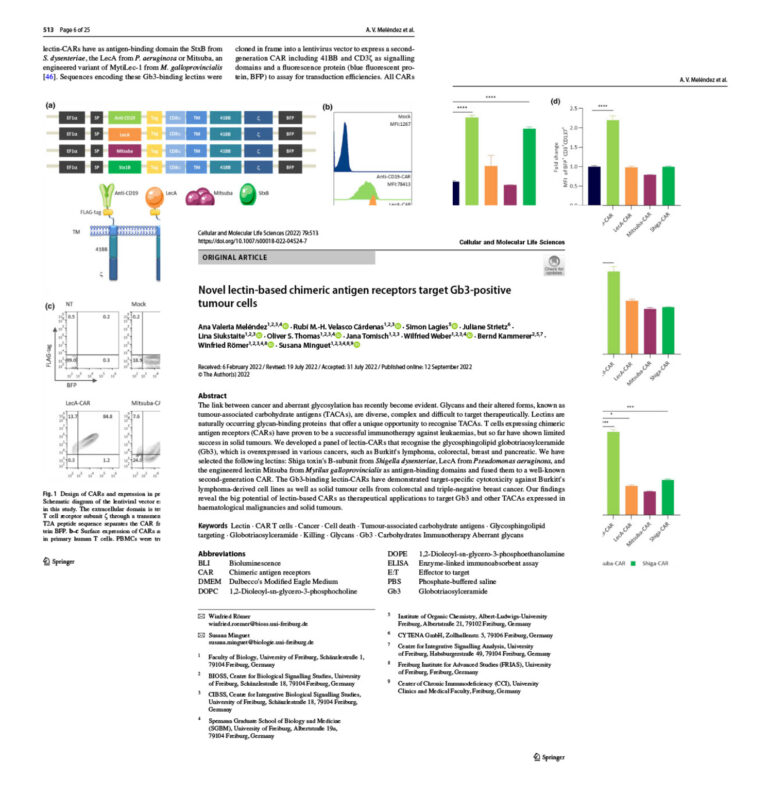
Novel lectin-based chimeric antigen receptors target Gb3-positive tumour cells
The link between cancer and aberrant glycosylation has recently become evident. Glycans and their altered forms, known as tumour-associated carbohydrate antigens (TACAs), are diverse, complex and difficult to target therapeutically. Lectins are naturally occurring glycan-binding proteins that offer a unique opportunity to recognise TACAs. T cells expressing chimeric antigen receptors (CARs) have proven to be a successful immunotherapy against leukaemias, but so far have shown limited success in solid tumours. We developed a panel of lectin-CARs that recognise the glycosphingolipid globotriaosylceramide (Gb3), which is overexpressed in various cancers, such as Burkitt's lymphoma, colorectal, breast and pancreatic. We have selected the following lectins: Shiga toxin's B-subunit from Shigella dysenteriae, LecA from Pseudomonas aeruginosa, and the engineered lectin Mitsuba from Mytilus galloprovincialis as antigen-binding domains and fused them to a well-known second-generation CAR. The Gb3-binding lectin-CARs have demonstrated target-specific cytotoxicity against Burkitt's lymphoma-derived cell lines as well as solid tumour cells from colorectal and triple-negative breast cancer. Our findings reveal the big potential of lectin-based CARs as therapeutical applications to target Gb3 and other TACAs expressed in haematological malignancies and solid tumours.
Cell Mol Life Sci. 2022 Sep 12;79(10):513
About us
Current research on γδ T cells and their γδ TCR focusses on the identification of potential ligands for the γδ TCR, the role of γδ T cells in the control of infectious diseases, and the potential of γδ T cells for novel therapies against tumors. Thus, γδ T cell research is a hot topic with a lot of potential for translation into clinical application. FOR2799 is a DFG-funded Research Unit, in which several German research groups join forces to investigate how “The γδ T Cell Receptor Receives and Translates Signals”.

